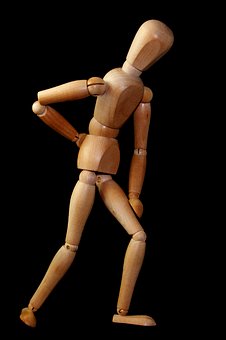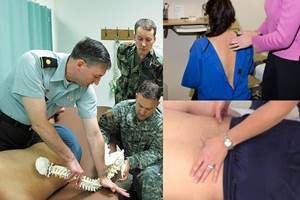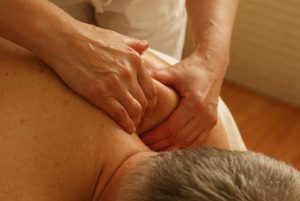You may remember your grammar school gym class where the PE teacher would lead you in jumping jacks, push-ups, sit-ups and arm circles. If you’re like a lot of baby boomers, you probably look back and assume it really didn’t do much for the health of the students — just kept the class busy for an hour.
Elementary school days may be way behind you, but exercise carries many benefits now that it couldn’t offer a younger you, especially if you’re battling pain from an injury or chronic condition.
The Journal of Manipulative and Physiological Therapeutics published a report on randomized controlled trials, or RCTs, looking at the result of exercise as treatment for patients experiencing intense pain from soft tissue injuries in the hip, thigh or knee. Success was measured by the following factors:
- Intensity of pain
- Recovery
- Quality of life
- Psychological outcomes
- Adverse events
“One RCT found statistically significant improvements in pain and function favoring clinic-based progressive combined exercises over a ‘wait and see’ approach for patellofemoral (anterior knee) pain syndrome,” the study says. “Patients with patellofemoral pain syndrome or groin pain had the best results with clinic-based exercise programs.”
Head to Head to Head
An ABC News blog posted study results comparing the outcome of three different forms of treatment for pain. Results show that patients treated by chiropractic professionals and the individuals who received home exercise advice, referred to as HEA, had higher rates of success than those who turned to medication for relief. Just 13 percent of the patients who took medication reported a satisfactory reduction in pain, whereas, about two-thirds of those who were treated through either chiropractic care (32 percent) or HEA (30 percent) said they were pain-free.
A total of 272 patients, ages 18-65, who were suffering from recent-onset neck pain took part in the study, which the National Institutes of Health spearheaded.
“I always prescribe exercises and/or physical therapy for neck pain,” wrote Dr. John Messmer from Penn State College of Medicine. “I also tell patients that the exercises are the treatment and the drugs are for the symptoms.”
Dr. Lee Green, professor of family medicine at the University of Michigan, also talked to ABC News. “Doesn’t surprise me a bit,” Dr. Green said. “Neck pain is a mechanical problem, and it makes sense that mechanical treatment works better than a chemical one.”
The study, which was published in the Annals of Internal Medicine, singles out the effectiveness of spinal manipulation therapy, or SMT, to provide relief for patients with neck pain. Researchers found that in both the short-term and long-term statistics, SMT had the most effective outcome. The report adds that HEA proved equally effective at some points in the study.
Participants rated their pain at several intervals: 2, 4, 8, 26, and 52 weeks. This enabled scientists to draw specific conclusions, such as the evidence showing that 12 weeks of SMT provided greater pain relief than up to one year of medication.
Chiropractic Benefits
Your chiropractor can not only provide pain releif and preventatiive therapies, they can also guide you in choosing exercises that target the areas you need treating. Chiropractic visits, in addition to home exercise practices, are a way to double down on your odds of successful treatment.
The Mayo Clinic website says there are multiple benefits to using exercise in addition to chiropractic care for your joints, as well as improving general wellness. In combination they serve to:
- Strengthen the muscles around your joints
- Help you maintain bone strength
- Give you more energy to get through the day
- Make it easier to get a good night’s sleep
- Improve your balance
We’re not talking about the kind of punishing calisthenics that win you the Presidential Physical Fitness Award, but something to just curb your symptoms and add some range of motion. Consulting with a chiropractor and incorporating some exercise seems to be the best way to get a passing grade in pain relief.
This article was written by Martha Michael and is shared from the following website: exercise-chiropractic-more-effective-than-medicine



 Palpation is the most frequently used diagnostic technique in chiropractic care and is a clinical cornerstone of most physicians’ practice. It is a manual, non-invasive method of determining where a patient has structural or functional problems in the body.
Palpation is the most frequently used diagnostic technique in chiropractic care and is a clinical cornerstone of most physicians’ practice. It is a manual, non-invasive method of determining where a patient has structural or functional problems in the body. Statistics compiled by the American Chiropractic Association (ACA) tell us that back pain affects a large majority of the population, with roughly 80 percent of people enduring at least one back-related issue during the course of their lives. In fact, there are currently 31 million people in the U.S. alone dealing with chronic, daily back pain.
Statistics compiled by the American Chiropractic Association (ACA) tell us that back pain affects a large majority of the population, with roughly 80 percent of people enduring at least one back-related issue during the course of their lives. In fact, there are currently 31 million people in the U.S. alone dealing with chronic, daily back pain. According to the National Institutes of Health, lower back pain is the second most common form of chronic pain after headaches. Experts estimate that approximately 80% of Americans will seek help for low back pain at some point during their lives. Public health officials and insurers estimate that Americans spend $50 billion each year on treatments that are often ineffective. The standard treatment for lower back pain is to take muscle relaxants, painkillers or anti-inflammatory medications, along with physical therapy and back exercises. However, few medical interventions relieve pain reliably, and continuing to take painkillers on a long-term basis is not advised. Massage, on the other hand, has been found to be an effective way of dealing with back pain on a regular basis.
According to the National Institutes of Health, lower back pain is the second most common form of chronic pain after headaches. Experts estimate that approximately 80% of Americans will seek help for low back pain at some point during their lives. Public health officials and insurers estimate that Americans spend $50 billion each year on treatments that are often ineffective. The standard treatment for lower back pain is to take muscle relaxants, painkillers or anti-inflammatory medications, along with physical therapy and back exercises. However, few medical interventions relieve pain reliably, and continuing to take painkillers on a long-term basis is not advised. Massage, on the other hand, has been found to be an effective way of dealing with back pain on a regular basis. Many studies have found that chiropractic care is a safe and effective treatment method when dealing with a number of spine-related issues. The American Chiropractic Association even lists a number of research studies on their website that show that it is a valuable treatment method for easing (and sometimes completely resolving) back pain, neck pain, headaches, and more.
Many studies have found that chiropractic care is a safe and effective treatment method when dealing with a number of spine-related issues. The American Chiropractic Association even lists a number of research studies on their website that show that it is a valuable treatment method for easing (and sometimes completely resolving) back pain, neck pain, headaches, and more. Back pain is an expensive health problem for both patients and businesses.
Back pain is an expensive health problem for both patients and businesses.  Manual therapies have been used to treat musculoskeletal disorders for thousands of years. Practitioners around the world—in countries with many different cultural influences and diverse medical traditions—have used their hands to manipulate various parts of the body to stimulate healing. “Manual” literally means “by hand.” Thus, manual therapies consist of healing techniques that use the hands. There are more than two dozen techniques used worldwide. Among the most commonly known are acupressure, chiropractic, massage therapy, physiotherapy, reflexology, Rolfing and shiatsu.
Manual therapies have been used to treat musculoskeletal disorders for thousands of years. Practitioners around the world—in countries with many different cultural influences and diverse medical traditions—have used their hands to manipulate various parts of the body to stimulate healing. “Manual” literally means “by hand.” Thus, manual therapies consist of healing techniques that use the hands. There are more than two dozen techniques used worldwide. Among the most commonly known are acupressure, chiropractic, massage therapy, physiotherapy, reflexology, Rolfing and shiatsu.